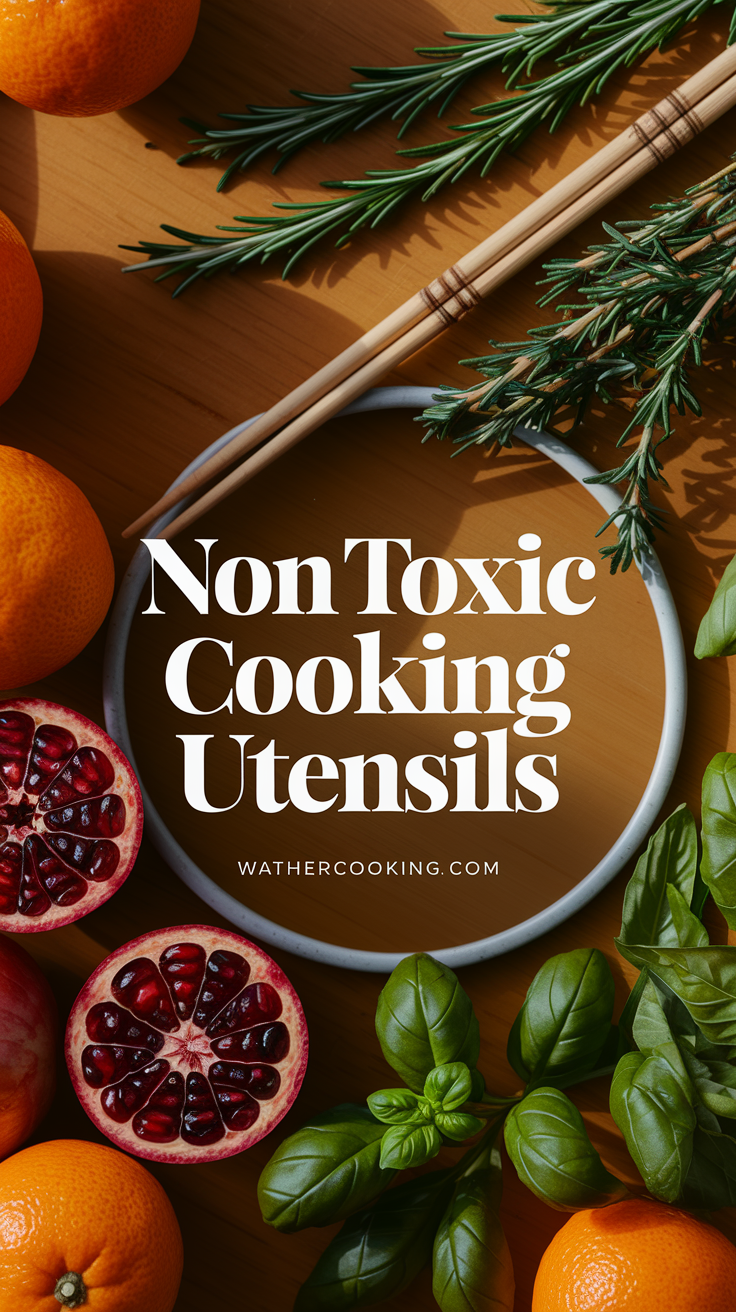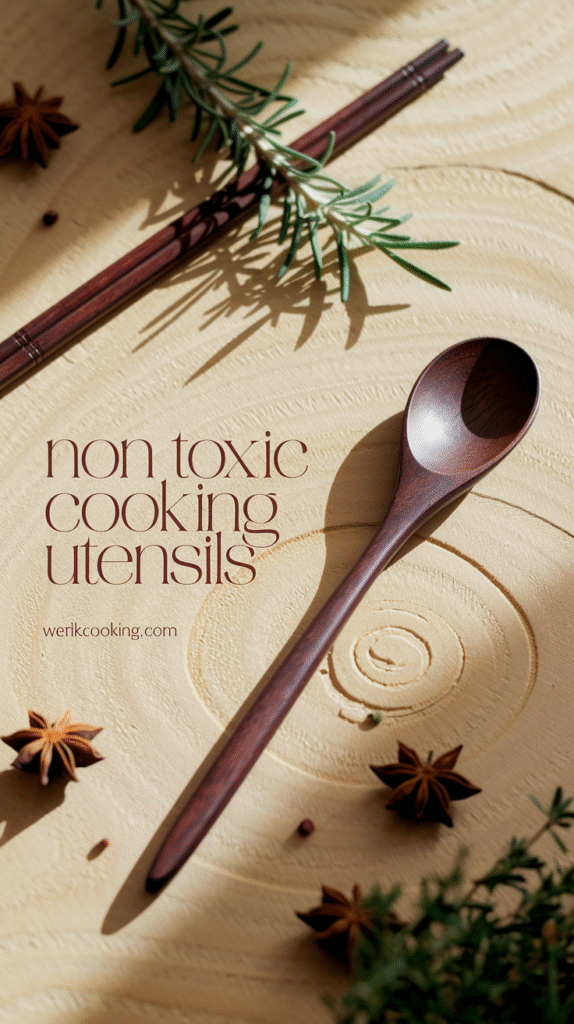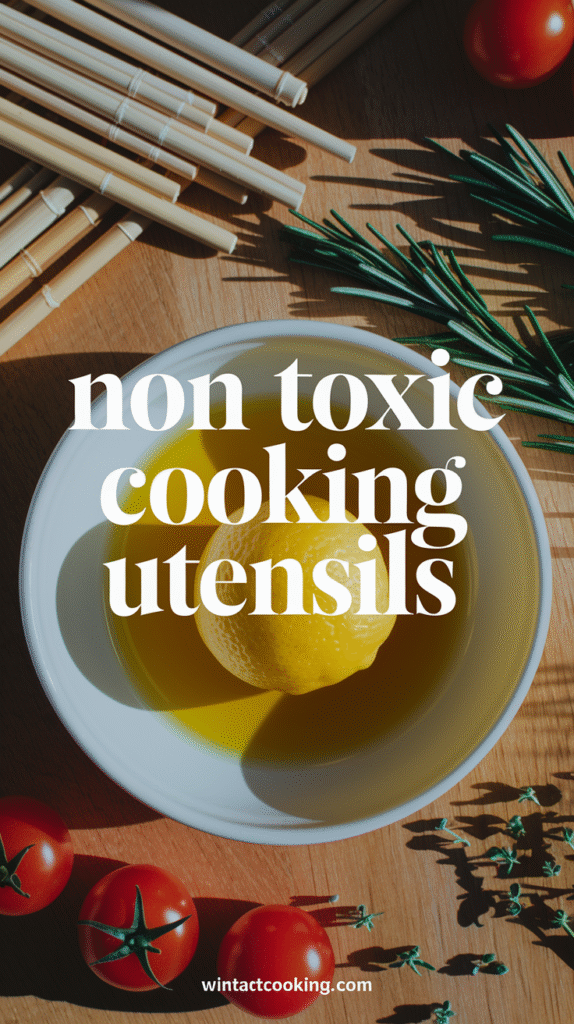When preparing meals, the tools you choose can impact your health more than you may realize. Non-toxic cooking utensils have gained popularity in recent years, and for good reason. These utensils are made from materials that do not leach harmful chemicals into your food. By opting for non-toxic options, you are protecting yourself and your family from potential health risks.
Many traditional kitchen tools are made from materials such as plastic and processed metals that can release toxins. These substances may include BPA, phthalates, and other harmful chemicals that can disrupt your endocrine system and negatively impact your health. By switching to non-toxic cooking utensils, you are making a wise decision for your well-being. Here are several major benefits:
Improved Safety
Non-toxic cooking utensils are designed to be safe for your health. Materials such as bamboo, silicone, and certain types of stainless steel are great alternatives to conventional options. These materials do not release harmful substances, even when exposed to heat. This means you can confidently cook your meals without worrying about toxic exposure.
Better Flavor and Nutrient Retention
When you use non-toxic materials, you can enhance the flavors of your dishes. Some toxic cookware can react with food, altering its taste. Non-toxic utensils help retain the natural flavors and nutrients, providing you with a healthier, more enjoyable meal experience.
Environmental Benefits
Choosing non-toxic cooking utensils often aligns with eco-friendly practices. Many of these products are made from sustainable materials. For example, bamboo utensils are biodegradable and do not contribute to plastic waste. By supporting environmentally responsible products, you are benefiting not only your health but also the planet.
Durability and Longevity
Non-toxic utensils often last longer than their conventional counterparts. High-quality stainless steel and silicone tools are resistant to corrosion and wear. Investing in durable cooking utensils means you won’t need to frequently replace them, making it a more economical choice in the long run.
| Material | Benefits | Environmental Impact |
|---|---|---|
| Bamboo | Lightweight, does not absorb flavors | Biodegradable, sustainable growth |
| Silicone | Heat-resistant, non-stick | Reusable, can be recycled |
| Stainless Steel | Durable, resistant to rust | 100% recyclable |
Allergy-Friendly Options
For those with sensitivities or allergies, non-toxic utensils provide a safer cooking environment. Many traditional materials can harbor allergens or react with certain foods. Non-toxic options such as silicone are hypoallergenic, ensuring you can prepare meals without concern for allergic reactions.
Ease of Cleaning
Non-toxic utensils are usually easier to clean than their toxic counterparts. For example, silicone is naturally non-stick, making it easy to wash and maintain. Bamboo utensils can simply be wiped down, while stainless steel can withstand the dishwasher. This not only saves time but ensures that your utensils remain hygienic.
As you consider upgrading your kitchen tools, it’s important to look for trusted sources. Websites such as EarthHero and Boontoon offer a range of non-toxic cooking utensils that prioritize your health. These resources are excellent starting points for finding safe and effective kitchen tools.
By incorporating non-toxic cooking utensils into your kitchen, you are making a positive choice for both your health and the environment. With benefits ranging from improved safety to better flavor and ease of cleaning, the advantages are clear. Start selecting non-toxic utensils today and enjoy healthier, safer cooking experiences for you and your loved ones!
How to Choose the Right Non-Toxic Cooking Utensils for Your Kitchen
Choosing non-toxic cooking utensils is an important step towards a healthier kitchen. Many traditional cooking tools can leach harmful chemicals into your food, which may have long-term health effects. In this article, you’ll learn key factors to consider when selecting safe, non-toxic cooking utensils that meet your culinary needs.
Understand Material Types
Different materials offer various benefits and drawbacks. Here’s a quick guide to some popular materials used in non-toxic cooking utensils:
| Material | Pros | Cons |
|---|---|---|
| Wood | Natural, biodegradable, does not scratch cookware | Requires maintenance, can absorb odors |
| Bamboo | Renewable resource, lightweight, strong | May splinter over time, less durable than hardwood |
| Silicone | Flexible, heat resistant, easy to clean | Quality varies, some may contain fillers |
| Stainless Steel | Durable, non-reactive, withstands heat | Can scratch non-stick surfaces |
| Glass | Non-reactive, easy to clean | Breakable, can be heavy |
Check for Safety Certifications
When shopping for non-toxic cooking utensils, always look for safety certifications. The following certifications ensure that products meet high safety and health standards:
- FDA Approved: Indicates that food contact materials are safe for use.
- BPA-Free: Confirming the absence of Bisphenol A, a harmful chemical often found in plastics.
- LFGB Certified: This German standard means the material is safe and food-grade.
Make sure to check product labels for these certifications to ensure you are making a safe choice. Brands that prioritize safety often highlight their certifications prominently on their packaging or websites.
Consider Ergonomics and Usability
Choosing utensils that feel comfortable during use is equally important. Ergonomics influences how well you can maneuver your cooking tools, reducing strain and injury. Here are some factors to consider:
- Handles: Choose utensils with grips that fit your hand size.
- Weight: Lightweight utensils can be easier to handle, especially for longer cooking sessions.
- Design: Look for tools that allow for easy stirring and flipping without damaging your cookware.
When possible, try gripping the utensils before purchasing to get a feel for their comfort level.
Prioritize Durability
Investing in durable non-toxic cooking utensils can save you money over time. Look for materials and brands known for their longevity. For instance, high-quality stainless steel or well-treated wooden utensils can withstand the test of time. Read customer reviews and feedback to gauge the durability of specific products.
Understand Maintenance Requirements
Maintenance is also a key consideration. Some materials require special care, so make sure you are prepared to take care of your utensils appropriately. For example:
- Wood: Needs occasional oil treatments to prevent drying and cracking.
- Silicone: Generally dishwasher safe but avoid heat exposure above the recommended temperatures.
Understanding maintenance will help extend the lifespan of your utensils and keep your kitchen safe.
It’s essential to stay informed about the products you choose. Websites like Environmental Working Group and Healthline provide valuable insights into safe materials and health risks associated with cooking utensils. These sources will help you make informed choices for your kitchen.
By taking the time to choose the right non-toxic cooking utensils for your kitchen, you are making an investment in your health and well-being. Always research and keep your family’s safety a top priority while enjoying your culinary adventures.
Common Materials Used in Non-Toxic Cooking Utensils and Their Advantages
When it comes to preparing your meals, the utensils you use can significantly impact your health. Many traditional cooking utensils contain harmful chemicals that can leach into your food. In contrast, non-toxic cooking utensils are made from safer materials, ensuring a healthier cooking experience. Let’s explore some common materials used in non-toxic cooking utensils and their advantages.
Silicone
Silicone has become a popular choice for cooking utensils due to its safety and versatility. Here are some advantages of silicone utensils:
- **Heat Resistant**: Silicone can withstand high temperatures, usually up to 600°F (315°C), making it perfect for cooking.
- **Non-Stick Surface**: Foods do not stick easily to silicone, which reduces the need for oils or sprays.
- **Dishwasher Safe**: Most silicone utensils are easy to clean and can be safely put in the dishwasher.
- **BPA-Free**: Unlike plastic, silicone does not contain BPA, ensuring that no harmful chemicals get into your food.
Wood
Wooden utensils have been used for centuries and are still favored today for many reasons:
- **Natural Material**: Wood is a renewable resource and generally does not transfer chemicals to food.
- **Gentle on Cookware**: Wooden utensils are soft and will not scratch non-stick pans.
- **Durable**: With proper care, wooden utensils can last a long time, making them a sustainable choice.
- **Aesthetic Appeal**: Wooden utensils often have a beautiful, natural look that complements any kitchen.
Stainless Steel
Another common material for non-toxic cooking utensils is stainless steel. This metal comes with several benefits:
- **Non-Reactive**: Stainless steel does not react with acidic or alkaline foods, keeping the taste of your meals intact.
- **Durability**: It is incredibly tough and resistant to rust, dents, and scratches.
- **Easy to Clean**: Stainless steel utensils can be cleaned easily, often being dishwasher safe.
- **Long-Lasting**: With appropriate care, stainless steel utensils can last a lifetime, making them a great investment.
Glass
Glass utensils are a lesser-known option, but they have unique advantages:
- **Non-Toxic**: Glass does not leach any chemicals, remaining entirely safe for food use.
- **Microwave Safe**: Most glass utensils can be used in the microwave, offering versatility.
- **Easy Visibility**: Transparent glass lets you see the food inside, ensuring better cooking.
- **No Staining**: Unlike plastic, glass does not stain or retain odors.
Cast Iron
Cast iron is another popular choice, especially for cookware. Its advantages include:
- **Excellent Heat Retention**: Cast iron heats evenly and provides consistent cooking results.
- **Durability**: With proper care, cast iron utensils can last for generations.
- **Adds Iron to Food**: Cooking with cast iron can increase dietary iron intake, beneficial for many.
Choosing non-toxic cooking utensils is essential for a healthy kitchen. By opting for materials like silicone, wood, stainless steel, glass, and cast iron, you can avoid the harmful chemicals found in traditional utensils. It’s a simple change that can lead to a safer cooking experience.
For more insights on non-toxic cookware and kitchen materials, you may find helpful information at Healthline and Academy of Nutrition and Dietetics.
The Impact of Non-Toxic Cooking Utensils on Food Taste and Quality
In today’s health-conscious world, choosing the right cooking utensils can significantly influence not only your cooking experience but also the flavor and quality of your meals. Non-toxic cooking utensils are gaining popularity for their ability to provide a safe cooking environment while enhancing the overall quality of food. By avoiding harmful chemicals, these utensils help retain the natural taste of ingredients and ensure your dishes remain healthy and delicious.
What Are Non-Toxic Cooking Utensils?
Non-toxic cooking utensils are kitchen tools made from materials that are free from harmful substances, such as BPA, phthalates, and heavy metals. These utensils are designed to withstand high temperatures without leaching harmful chemicals into your food. Common materials used for non-toxic cookware include:
- Silicone
- Stainless Steel
- Wood
- Bamboo
- Glass
Benefits of Non-Toxic Cooking Utensils
Using non-toxic cooking utensils can positively affect both taste and the nutritional quality of your food. Here’s how:
1. Preserving Food Flavor
Many traditional cookware materials, like non-stick coatings, can impart undesirable flavors to your food. Non-toxic utensils, on the other hand, maintain the integrity of flavors. For instance, stainless steel doesn’t react with acidic ingredients, ensuring that the natural taste is preserved.
2. Ensuring Food Safety
Opting for non-toxic options decreases the risk of chemical leaching into your food. This can be particularly critical when cooking at high temperatures. Utensils made from glass or ceramic do not react with food, thereby preventing any potential taste interference due to chemical reactions.
3. Enhancing Texture
The right utensils also influence the texture of your meals. For example, wooden spoons are gentle on pans and prevent scratches, which in turn keeps the non-stick surface intact. This promotes even cooking, leading to a more enjoyable culinary experience.
Comparing Different Materials
The effectiveness of non-toxic utensils varies by material. Below is a brief comparison of popular options:
| Material | Pros | Cons |
|---|---|---|
| Silicone | Flexible, non-stick, heat resistant | Can retain odors |
| Stainless Steel | Durable, non-reactive, easy to clean | Poor heat conduction |
| Wood | Strong, gentle on cookware | Might absorb flavors and smells |
| Bamboo | Eco-friendly, lightweight | Less durable than wood |
| Glass | Non-reactive, retains food taste | Brittle and breakable |
Impact on Cooking Experience
Using non-toxic utensils can create a more enjoyable and mindful cooking experience. When you know your cooking tools are safe, it allows you to focus on honing your culinary skills and experimenting with new recipes. You can enjoy the process of cooking without worrying about harmful chemicals infiltrating your meals.
Choosing the Right Non-Toxic Utensils
When selecting the best non-toxic cooking utensils for your kitchen, consider the following:
- Evaluate your cooking habits and choose materials that fit your lifestyle.
- Research brands that prioritize safety and sustainability.
- Look for products that have certifications regarding their chemical safety.
Non-toxic cooking utensils into your kitchen can have a lasting impact not only on your health but also on the flavor and quality of your food. By making informed choices about the materials you use in your cooking, you can enjoy delicious meals that are both safe and nutritious.
To learn more about the benefits of non-toxic cooking utensils and to explore options for your kitchen, visit Healthline and Eatwell101.
Tips for Maintaining and Caring for Non-Toxic Cooking Utensils
Choosing non-toxic cooking utensils is a great step towards a healthier kitchen. Once you’ve picked the right utensils made from safe materials, it’s essential to maintain them properly so they can last longer and continue to provide a safe cooking environment. Here are some valuable tips for maintaining and caring for your non-toxic cooking utensils.
Cleaning Guidelines
Cleaning is crucial for maintaining your non-toxic cooking utensils. Here are some effective methods:
- Hand Wash: Always hand wash your utensils whenever possible. Use warm, soapy water and a soft sponge to avoid scratches.
- Avoid Harsh Cleaners: Do not use bleach or strong chemical cleaners. Opt for natural cleaners such as baking soda or vinegar, which can effectively remove stains.
- Frequency: Clean your utensils after every use to prevent the buildup of bacteria and food residue.
Drying Techniques
Proper drying techniques can help preserve the integrity of your utensils:
- Air Dry: After washing, let your utensils air dry completely. This helps in eliminating moisture that can lead to bacteria growth.
- Avoid Dishwashers: Unless specified by the manufacturer, avoid placing your non-toxic utensils in the dishwasher as high heat can warp or damage them.
Storage Solutions
Correct storage is another key element in utensil maintenance:
- Designated Space: Store your cooking utensils in a designated drawer or container to prevent them from getting scratched or damaged.
- Use Dividers: Consider using dividers or organizers to keep different types of utensils separated to maintain their shape and functionality.
- Protective Materials: When storing, use cloth or soft materials to prevent scratches between utensils, especially for cookware like wooden spoons or non-stick spatulas.
Regular Inspection
Inspect your utensils regularly to catch any potential issues early:
- Check for Damage: Look for any cracks, chips, or discoloration. These can compromise the safety and effectiveness of the utensils.
- Replace When Necessary: If you notice any significant damage, it’s best to replace the utensil rather than risk contaminating your food.
Material-Specific Care
Not all non-toxic utensils require the same care. Here’s a brief guide for commonly used materials:
| Material | Care Instructions |
|---|---|
| Wood | Hand wash and apply mineral oil occasionally to keep wood from drying out. |
| Bamboo | Similar to wood, bamboo should be hand washed. Avoid soaking in water. |
| Silicone | Can be washed in warm, soapy water or placed in the dishwasher if specified by the brand. |
| Stainless Steel | Use vinegar and baking soda for deep cleaning and maintain shine. |
Heat Protection
Preventing overheating is crucial for the longevity of your cooking utensils:
- Use Low to Medium Heat: For non-toxic cookware, avoid high heat settings which can warp or damage utensils.
- Use Proper Utensils for Cooking: Select utensils that match the cooking methods, e.g., silicone spatulas for non-stick pans.
By taking these steps, you ensure that your non-toxic cooking utensils remain in excellent condition, providing a safe and effective cooking space for you and your family. For more information on non-toxic kitchen products, check out EWG’s guide to safer cookware and Healthline’s tips on choosing cooking utensils.
Making these simple changes to your routine can have a significant impact on the lifespan and safety of your kitchen tools. Happy cooking!
Conclusion
Embracing non-toxic cooking utensils can lead to a healthier kitchen and improved well-being. By prioritizing your health, you can reduce harmful chemicals that may leach into your food. This transformation begins with understanding the benefits of using materials that are safe and eco-friendly, shielding your family from potential hazards.
Choosing the right utensils involves knowing which materials—like bamboo, stainless steel, and food-grade silicone—work best for your cooking style and needs. Each of these materials comes with its unique advantages, such as heat resistance and durability, ensuring that your utensils not only last longer but also maintain the flavors and quality of your meals.
Your food’s taste and quality can significantly improve when cooked with non-toxic utensils. These tools are designed to enhance rather than detract from the natural flavors of your ingredients. This brings about a richer cooking experience that is both enjoyable and beneficial for your health.
Moreover, taking care of these utensils is essential for maximizing their lifespan and performance. Simple maintenance tips, like hand washing and avoiding harsh chemicals, can help keep your non-toxic utensils in top shape and ready for everyday use.
By making the switch to non-toxic cooking utensils, you are investing in your health and enjoying a more flavorful culinary experience. With the right choices and care, you can enhance not just your kitchen but your overall lifestyle, proving that what you cook with is as vital as what you cook.






Leave a Reply